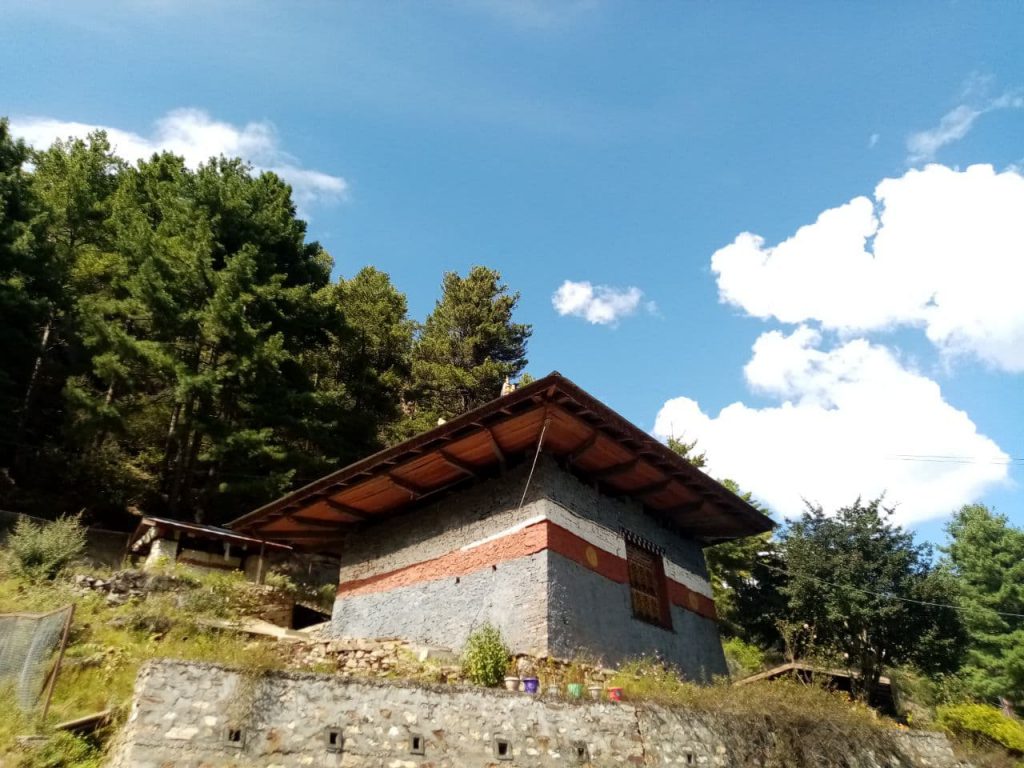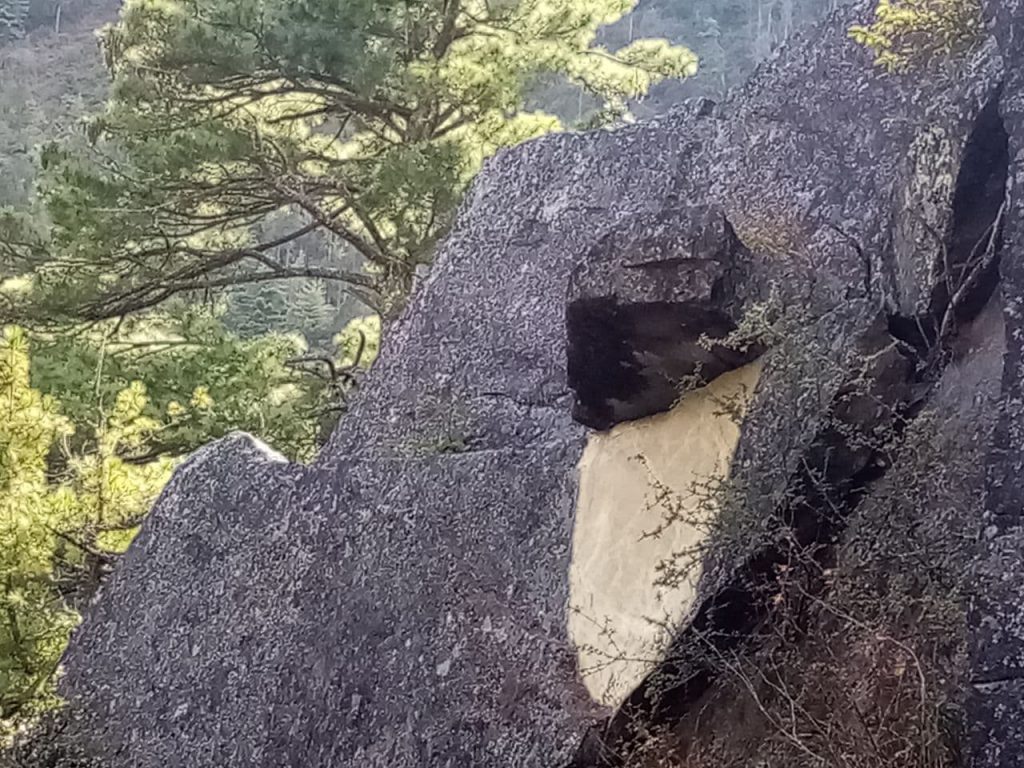
The Lhakhang Nagpo is a 10-15 minutes’ walk toward the north of the Lhakhang Karpo. It is located at the base of lord Avalokiteshvara (Chenrezig) mount at an altitude of 3,411 meters away from sea level. The Lhakhang stands adjacent to the Dumchoe village under Uesu Gewog.
History
An oral account narrates how one realized Buddhist master arrived in the Haa valley before there was any human settlement. He pondered to have a settlement in the valley for which the construction of a Lhakhang was considered indispensable for the purpose. While thinking about it, coincidently two pigeons, a black and a white flew from nowhere towards the direction where the present location of Lhakhang Karpo and Nagpo stands.
Another source claimed that the Lhakhang was built around the 7th century by Songtsen Gampo, the 33rd ruler of the Tubo Regime in Tibet. He manifested in the form of two pigeons – a white and a black to locate the present sites of the Lhakhang namely Karpo and Nagpo. It is said that people appeared out of nowhere and constructed the two temples miraculously. That is the reason for associating the name of the place with ‘Hah’ (ཧད), which literally means ‘suddenly’.
However, according to the Biography of the Songtsen Gampo’s ‘Bka Chems Ka Khol ma’ (བཀའ་ཆེམས་ཀ་ཁོལ་མ) (1991), only Bumthang’s Jampa Lhakhang and no other Lhakhang of 108 Lhakhangs built by the Songtsen Gampo was mentioned. Similarly, Tashi (2017) in his articles བོད་ཀྱི་ས་དབྱིབས་སྲིན་མོ་གན.རྒྱལ། also mentioned that different articles and sources have mentioned different names of the Lhakhangs and places constructed during the era of Songtsen Gampo. This provides opportunity for the next researchers to verify the information accordingly.
Whatever may be the historical chronology of the Lhakhang Karpo and Nagpo is, according to Nangdor (2019), in order to tame the demon that disturbed the Himalayan Regions during the era of Songtsen Gampo, as a part of nail twelve, Lhakhangs were constructed over the body of demon. It includes Bumthang’s Jampa and Paro’s Kichu Lhakhang. He further states that apart from these twelve Lhakhangs, 1002 more Lhakhangs were built to suppress or counter the demonic force. These evidence provides an opportunity to research that Lhakhnag Karpo and Nagpo also belong to the 1002 Lhakhangs constructed during the Songtsen Gampo era.
The main relics inside the Lhakhang considered to be ancient are: Jowo Skyamuni (historical Buddha), Tadin (Hayagriva), Chana Dorji (Vajrapani), and Buddha of Expiratory Rituals deities (སྐང་བཤགས་ལྷ་ཚོགས) and mural paintings. The relics that were installed recently are the statue of Zhabdrung Rinpoche, Songtsen Gampo and the Guru Padmasambhava.
According to Lama Penchu (personal communication, October 9, 2021), it is believed that one of the main relics namely Jowo Shakyamuni (historical Buddha) belonging to the Lhakhang and the statue of Jowo Shakyamuni at Lhasa is the same. A Tibetan Geshe narrated this oral account to one of the Dashos from Bhutan during their conversation. The Geshe was believed to have asked the dasho: “why you are coming to Lhasa since the same blessing from Jowo Shakyamuni statue was at the Lhakhang Nagpo in Bhutan.” Upon hearing this, Dasho returned to Haa and visited Lhakhang Nagpo to verify it. The Dasho found that the statue of Jowo Shakyamuni in Lhakhang was exactly the same in terms of size, height and appearance with the one in Lhasa except for the ornaments. This account also proves that in terms of accumulating merit from the blessing of Jowo statue at Lhakhang Nagpo, it is considered equivalent to the Jowo blessing from the statue of Lhasa.
In an another interesting narrative, Tshering (personal communication, October 9, 2021) highlighted that when the plague epidemic broke out in early 1980s killing people in large numbers across the country, the Haaps survived the epidemic as the Jowo took himself the disease and saved the people. Thereafter, it is believed that the marks left by the disease on the abdomen of the Jowo is still visible to this day. This justifies why the Haaps worship the Jowo with unshakable faith.
Sacred sites inside the Lhakhang is Pal Yeshey Gempo’s La-tsho (lake where gods and nagas live). In this La-tsho, Tshomen (a lake spirit) Dechen Gyalpo resides as a protecting deity. According to the Lam, in the past this La-tsho used to be filled to the brim almost to the point of overflowing. He also narrated that sometimes without a concern and prior permission from the caretaker/lam, visitors used to pour milk and offer ngultrum inside the La-tsho and turn it into a colorful pool triggering an overflow. In order to avoid such incident, a concrete protection was constructed to stop the overflow, and a glass cover was installed to prevent the money or other offerings to get into the pool during the recent renovation that was carried out. From there on La-tsho never filled to the brim and remained only half filled. Today, La-tsho remaining half-filled is worrying since it is not clear whether it is due to defilement or any other causes. Only the future researchers can tell.

Pel Yeshey Gempo’s Rangjoen (natural raising) Kilkor (mandala) is the only sacred site around the Lhakhang Nagpo. Essential Guide to Sacred Sites, volume IX (2016), highlighted ‘sacredness of Kilkor. It has mentioned that while people offering white khenpashing Sang (purification through smoke), a crow came and it is considered a Choiechung–sung-ma (guardian deity). This incident let to form a strong belief among the locals that the crow is not a bird and it is a guardian deity. Until today, a tradition of Ola-chag-tshel-lo (offering to a crow)is prevalent in the community.This is authenticated by the presence of Pel Yeshey Gempo’s Kilkor (Mahakala’s Mandala) sacred site just above Lhakhang on the rock. It is visible for the visitors since the devotees have painted the image of the Pel Yeshey Gempo’s Kilkor (Mandala) in gold.
Other sacred sites around the Lhakhang is located at Yipri (now known as Kipri) [གཡིབ་རི། སྐྱིདཔ་རི། ] just 15 minutes’ walk towards north-west of the Lhakhang Nagpo. This sacred site is called Be-dang-kha, which mean ‘subdued place of the snake’. An oral narrative has it that the villagers of Yipri (གཡིབ་རི)/Kipp-ri (སྐྱིདཔ་རི) were haunted by a demonic force that manifested into a snake (presently believed to be a deity of Shelkardrak) and they hid themselves from the demon. It was only after the Guru Rinpochhe tamed the demon, the life in the village returned to narmalcy. That is how the village came to called today as Yipri (Kipri). During the 8th century, when Guru Rinpoche subdued the snake, the place was known as Be-dhang-kha. In this sacred site, one can see image of the whole snake and the body print of the Guru Rinpoche on the rock. According the oral sources, it is said that even today when our win-horse (Lung-ta) is low people could see the snake indicating a bad omen. However, if one’s wind-horse (Lung-ta) is high, the lucky one would see the Dungkar (conch) which is the symbol of the good omen.
The mural painting that were seen in the Lhakhang are; Zhabdrung Phunseum Tshogpa, Neeten Chudrug (Sixteen Arhats), Mithrugpa lhatshog deities (Aksobhya Buddha).
In the beginning, the Lhakhang Nagpo is taken care by the village community. However, prior to early 1980s, one Boepa Lodrue served as a first lama with the patronage of Kirii village and second Lama was Nag-gay. After lam, Nag-gay there was no lam to take care the Lhakhang, so the community handed over to the Zhung Dratshang. The first Zhung Dratshang lama was Ponpung, followed by Tsherimg Nidup and third in line is Lam Penchu.
Architectural Style
The one-story Lhakhang was constructed using traditional Buddhist architecture similar to the Tibetan. The outer structure, the inner walls, and the surroundings have remained the same since it was built without any major damage. That could be the reason why the Lhakhang has never seen any major renovation.
In the past, with two stupas of Rig-Sum-Gempo (lord of the three families) placed on the right and left of the Lhakhang Nagpo, the history of its construction in terms of date is unclear but people generally believe that it was built during the era of Galpo Songtsen Gampo in the 7th Century AD. The minor renovation works were carried out in 2019 such as the re-roofing with metal sheets and the painting around the wall. The additional cottage that one can see in front of the Lhakhang are lama’s resident, a kitchen and toilet.
Social and Cultural Functions
Some of the major social, religious, and cultural activities that are organized at the Lhakhang Nagpo are Yarngo and Marngo, a practice in dedication to the triple gem and sentient beings are held monthly. During this time, they generally perform rituals of Tshepai (Buddha of Longevity ritual) and Neteen chudruk chokha (sixteen arhats) ritual. On the 3rd Month of the Bhutanese calendar, Zhabdrung Dhanang mai ritual is conducted. Namjom and Tshepai ritual is observed in the 4th month of the Bhutanese calendar. A general ritual was conducted on the descending day of Lord Buddha according to the convenience of the 9th month of the Bhutanese calendar. However, on the 10th month of the Bhutanese Calendar invocation to Pal Yeshey Gonpo (Mahakala) is performed.
References
སྲོང་བཙན་བསྒམ་པོ། (1991) བཀའ་ཆེམ་ཀ་ཁོལ་མ། TBRC
ཧཱ་རྫོང་ཁག་སྨོན་ལམ་ཆེན་མོ་ཐེངས་བཅུ་དགུ་པ་ (༢༠༡༩) སྲོལ་འཛིན་ལས་ཁུངས། (༢༠༡༦) གནས་ཡིག་ཀུན་ཕན་ལམ་སྟོ། ཅ་རྙིང་
འཛིན་སྐྱང་སྡེ་ཚན།
རྡོ་རྗེ་བཀྲ་ཤིས། (༢༠༡༧) བོད་ཀྱི་ས་དབྱིབས་སྲིན་མོ་གན་རྒྱལ། Retrieved from
http://tb.gnxblzx.com/index.php?m=content&c=index&a=show&catid=10&id=1730
སྣང་རྡོར། (༢༠༡༩) བོད་ཡུལ་གྱི་མི་འགྱུར་བའི་གཟེར་བཅུ་གཉིས། Retrieved from
http://tb.tibet.cn/tb/folkways/new/201910/t20191028_6700272.html
 1375
1375